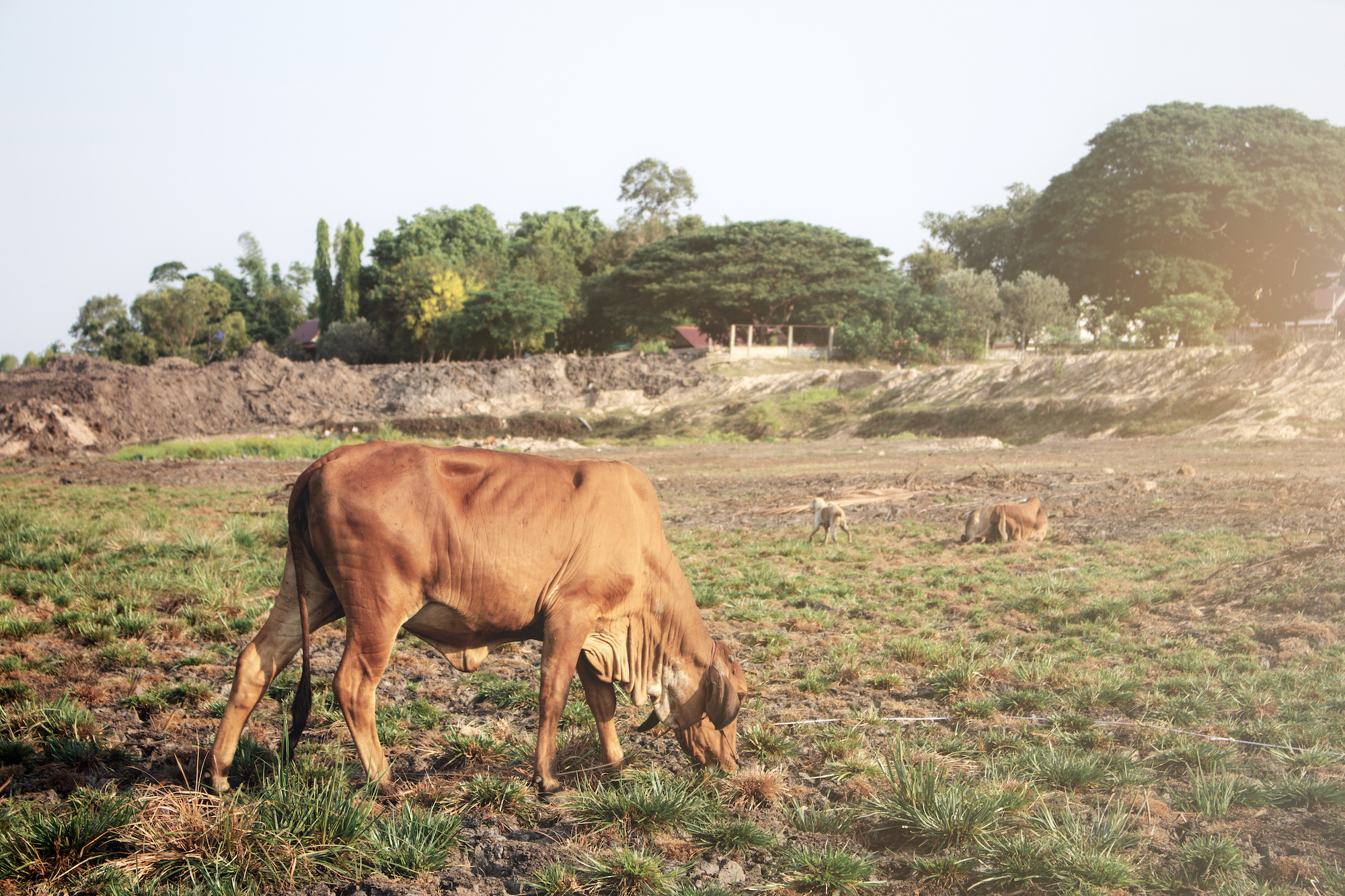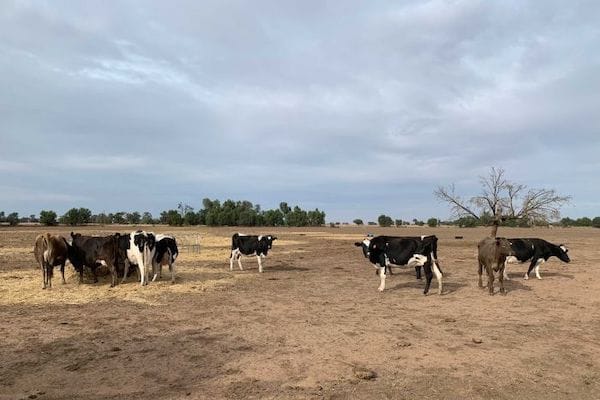As a progressive farmer, you are looking to be profitable, always.
However, during drought, fodder prices increase, beef prices might fall, and you run a higher chance of your animals falling sick. You need to take tough decisions.
Let me share a few strategies that might help you navigate drought.
Stages of drought
First, it can be useful to classify drought into a few categories, such as:
- Normal conditions: Your production is not affected by your climate. Ground covers grow well.
- Stressed conditions: Slight to moderate heat stress. Below average ground cover and low soil moisture.
- Progressing to a drought: Animals are affected, sparse ground cover. Low moisture levels in the soil.
- Drought conditions: Animals are affected. Minimal ground cover. Low soil moisture.
- Intense Drought: Persistent drought conditions. Animals extremely affected. No rains for 6 – 12 months.
Identifying your stage of drought can help you take the necessary action to reduce your damage.
Planning for a drought
Next, you have to come up with a drought management plan. This is your best bet in navigating drought.
You have to be realistic in your assessment of the situation. It is vital for you not to underestimate the money, fodder and water you will need to see you through the drought.
You need to have a plan, act on it early, review outcomes and then keep revising the plan. Here are some inputs that can help you plan better.

Find your biggest constraint and address it
In a drought, you are always going to face shortages. However, you must identify your biggest constraint early on. Because everything else won't matter once you run out of this.
Your biggest constraint could be anything you need for your operations. Most likely it would either be water, fodder, supplements, vaccines or cash.
Identifying your biggest constraint is important for two reasons. One, it helps you prevent significant losses. And two, it helps you take action, to address this.
For example, fodder might be your biggest constraint. In this case, you should prioritize purchasing more fodder as quickly as possible, before the drought intensifies and fodder prices go further up.
Or for example, if cash is your biggest constraint, then you might need to apply for government help, arrange for a loan or cut down operations to match how much cash you have.
Of course, you would not be able to predict outcomes perfectly. You might even get them wrong at times. Nevertheless, planning helps you be pro-active about the situation. It puts you in a better position to take effective decisions.
Plan to break-even
In a drought, you can face severe losses. It is a massive win if you turn a profit or break-even during such a tough time.
You should have a realistic plan to ensure that your expenses don’t overshoot your income significantly.
To do this, you need to list down all your foreseeable farm expenses. It might be useful to do this in a spreadsheet. This can help you review your expenses either by category or by highest expense value.
Ruthlessly find areas that you can cut costs. Cut all non-essential expenses if needed. Think carefully about how these cutbacks might affect animal welfare, employees, and long-term sustainability.
Make the necessary trade-offs and arrive at your lowest possible expense scenario. Add a ten percent buffer, and this will tell you of how much cash you need in the immediate future, to remain profitable.
Find a way to earn enough to cover these expenses even if this means losing out on opportunities to make better profits in the future. Because you have to first be in business before you can earn higher profits later.
If you are unable to find a way to break-even on paper, it is unlikely that you will be profitable in reality, unless a miracle happens. But they don't happen too often. Otherwise, they wouldn't be called a miracle. So nailing your break-even plan is critical. It becomes even more critical, during drought.
Monitor, review and adjust your plan
Plans aren't perfect. No plan is. So your outcomes will depend on how well you adapt your plans according to reality. Use your network to stay informed and keep track of key facts. And most importantly, take decisive decisions based on facts.

Six strategies to avoid losses during drought
1. Selling stock
2. Production feeding
3. Maintenance feeding
4. Agistment
5. Trading in Livestock
6. Humane Destruction
1. Selling stock
The animal condition and market prices are the two most critical factors while selling your animals.
In general, during drought, the sooner you sell stock, the better it will work out. Because, both your stock condition as well as market prices are likely to be better, early in drought. Both might also get progressively worse as the drought intensifies.
But more importantly, selling stock gives you cash, to help you better handle the drought. It also reduces related feeding, water, management and upkeep costs.
You can consider retaining your most healthy stock animals that are more likely to handle the drought and will be more productive after the drought. This will also hedge your bets, in case the drought doesn’t last for too long.

2. Production feeding
An alternate drought strategy is to maintain a certain level of production. You would do this when your slaughter stock is in premium condition and when you foresee an increase in beef prices.
You might also do this in case you believe that the drought will not last for long and you have the resources to see you through this tough period. Most often than not, this means buying fodder, supplements, and other resources at a higher cost.
Compared to the safe bet of selling stock early on, this strategy has more risk associated with it. However, the payoff can also be several times more if you happen to be right.
3. Maintenance feeding
Maintenance feeding takes a more balanced approach. It is neither as low risk and reward as selling stock early. Nor is it as high risk and reward as the production feeding option.
You decide to provide just enough
feed and supplements to maintain the bodyweight of animals. This is usually much lower than what you would give them while optimizing for production quality.This might be an attractive option if you already have reserves of hay, haylage or silage. It can also be an attractive option if you have other avenues or income. However, during extended periods of drought, maintenance feeding can become very expensive very quickly.
You could consider maintenance feeding in combination with selling stock.
4. Agistment
Agistment is an arrangement where the owner of an animal sends it to the property of a caretaker to be fed and cared, for a fee. Fees may depend on the type of animal, live weight of the animal or weekly costs.
This can be a useful strategy to cut losses and still maintain ownership of animals. This is a good strategy when the drought is local to a particular region, and you can find a reliable caretaker.
A written agreement can be useful in formalizing the duration, agistment costs, supplementary feed costs and other aspects of the arrangement.
Please note that it is a legal requirement for owners to record livestock movements to and from agisted properties on the National Livestock Identification System (NLIS) database.
5. Trading in livestock
Many farm owners don’t consider trading in livestock for several reasons. Most of them are solid.
However, the truth is that market prices for livestock can fluctuate widely during drought. This means there might be opportunities to buy good livestock profitably. So keep your eyes open.
6. Humane destruction
Humane destruction of your animals can be necessary sometimes. Especially when livestock prices have hit rock bottom or when your animals are not fit to be transported.
Humane destruction of an animal should be carried out to prevent suffering and distress. It is better than allowing your animal to die of hunger or thirst. You can also be penalized for this under the prevention of cruelty to animals act.
It should only be carried out by skilled persons using appropriate methods. In some conditions, you would consider humane destruction when your animals have fragile body conditions, loss of appetite, inability to rise, or disease. In other cases, you might consider this when there is low availability of feed and water or when it is either extremely hot or cold.
This brings us to an end. Drought is a tough situation, and you need to make tough decisions to survive it. But it need not be any harder than it needs to be.
I hope this was useful to you. If so, please share this with other farmers you know. You may like this article on the main problems facing Australian dairy farmers. Also, if you have any questions, please ask them as a comment below. I promise to answer it for you.
Until we meet again.
Happy farming!
- The Dedicated Team of Pasture.io, 2020-04-08